#Janipes
Explore tagged Tumblr posts
Text
Fossil Novembirb: Day 15 - Oasis in the Desert

During the Late Eocene and Early Oligocene, the environment of Jebel Qatrani formation of Faiyum, Egypt was as lush as you could imagine, with tropical forests, and a vast system of wetlands, lakes and rivers connecting to the warm Tethys Sea. As you would expect, such a place was teeming with birds. The birds living here would have no idea that 30 million years later, the Sahara desert would bury all this greenery. But for now, it is an oasis where birds of a feather flock together.
Goliathia: One of the earliest known relatives of the shoebill, arguably one of the most awesome birds alive today.
Nycticorax: An early member of the modern night-heron genus. It is not named, but can be assigned to the genus thanks to the shape of its limb bones.
Xenerodiops: An early member of the stork family with a short, recurved beak. It probably fed like modern wood storks, probing the water with the beak open, snapping it shut on passing fish.
Nuphranassa: A member of the modern jacana group, but much larger than any living species at about the size of a chicken.
Janipes: Another large jacana. Not as large as Nuphranassa, but still larger than any modern jacana. One must wonder what these guys were walking on.
Palaeoephippiorhynchus: An early stork well known from this period. It closely resembles the saddle-billed and black-necked storks, but was markedly smaller in size.
Eremopezus: A very poorly know flightless palaeognath known from a few fragmentary limb bones. Probably related to modern ostriches.
#Fossil Novembirb#Novembirb#Dinovember#birblr#palaeoblr#Birds#Dinosaurs#Cenozoic Birds#Goliathia#Nycticorax#Xenerodiops#Nuphranassa#Janipes#Palaeoephippiorhynchus#Eremopezus
57 notes
·
View notes
Text
Very late on this one but I think theres some cool stuff to talk about.
I actually covered this formation extensively a few years ago when giving the Wikipedia page a major overhaul at the request of someone on discord, so the research phase for Josch was mercifully easy (at least for me, not so much for those making the reference size chart).
Really one of the main things that the research focused on was which localities to choose. For reference, Jebel Qatrani spans the Eocene-Oligocene boundry and has localities representing different time intervalls. For example, locality L-41, which is the single most specious, was deposited during the Late Eocene, localities A and B right after the boundry and localities I and M are among the most recent. After some debating I and M kinda cristalized into the main ones to use, they are pretty close together so the fauna was likely to overlapp a good deal, they had some iconic animals and they also preserve a bulk of the bird fauna, which really helped fill lots of the space to not overcrowd with mammals.
Obviously my personal highlight was the featured crocodilian, Eogavialis africanum. Right out of the gate its an interesting one. Traditionally, Eogavialis, like other closely related forms (informally "thoracosaurs") have been recovered as some type of gharial, generally closer to Indian Gharials than Tomistoma (in old phylogenies featuring Tomi as a crocodylid, thoracosaurs are still deemed gharials proper).
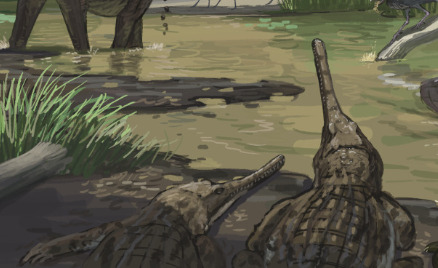
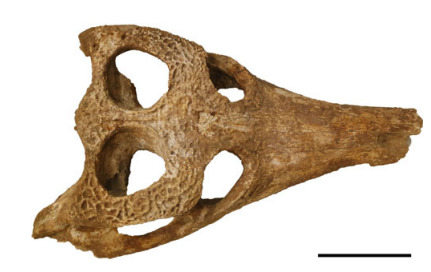
Now I initially had like three whole paragraphs typed on why I don't think this is the case, but for brevity's sake I'm going to save that for a future post on thoracosaurs in general (perhaps its something to cover after I'm done with mekosuchines). So for now, just know that tho it could be an early African gharial, its also possible that Eogavialis is a member of a much more ancient, non-crocodilian group of Eusuchians that just happens to look similar to gharials and that went extinct during the Miocene.
Also fun fact, the patterns and colours are based on modern day broad-snouted caimans.

Also while not featured in this piece I wanna give a shout out to "Crocodylus" megarhinus, a more robust crocodilian from the formation. As you can guess from the "", its no longer thought to belong to Crocodylus but is its own, still unnamed genus, interestingly closely related to the enigmatic mekosuchines endemic to Oceania. The size chart below also features Crocodylus articeps, the slender jaws at the very bottom. Though this species was long deemed a juvenile "C." megarhinus, comparisson with actual juveniles of the latter shows this to be obviously false. Alas the holotype has been lost and it is now deemed a nomen dubium.
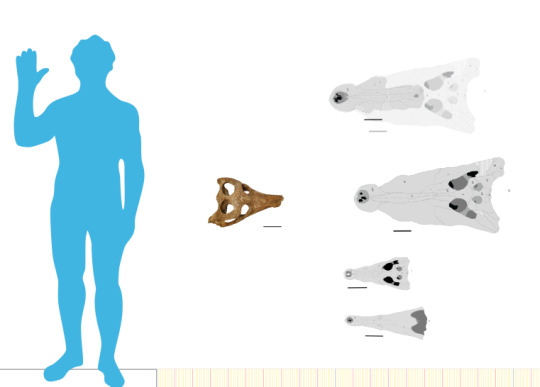
I also wanna give a brief shout out to the bird fauna, which is quite interesting in its own right and features a lot of taxa that match the swampy environment depicted here. For instance there's Palaeoephippiorhynchus, a large stork related to saddle-bills, marabous and jabirus and in a similar size range. There's also Goliathia, a "giant" shoebill. Though, as it turns out, the holotype is smaller than a modern shoebill and one of the referred specimens is only slightly more robust in some ways and not in others. So while interesting, its name (envisioned for what was assumed to be a heron) is not that fitting anymore. Speaking of heron, there is also Xenerodiops, with its uniquely shaped bill. Some researchers have argued that this genus was a type of night heron based on a humerus, though here it is depicted as more generalized given that the humerus and holotype bill have no direct evidence for having belonged to the same animal.
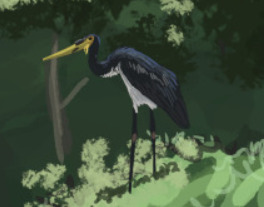
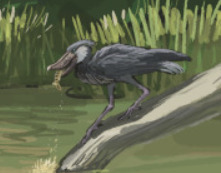
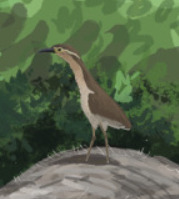
My personal favourites among the birds are the local flamingos and lilly trotters. Flamingo are represented through remains similar to those of Palaelodus (which I talked about in greater detail here and here) and thus likely belonged to that genus or another palaelodid. In short, these birds likely already had a diet not dissimilar to modern flamingos, but lacked the extreme bill curvature. Lilly trotters are better known from the formation and represented some of the earliest records of this family. Three species in two genera have been named, with this one in particular being Janipes, here depicted similar to a pheasant-tailed jacana, which is closely related to at least one of the two Jebel Qatrani jacanas (Nupharanassa specifically). It's been noted that all jacanas from this formation are larger than their modern kin.
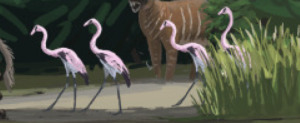

Obviously theres a lot more cool stuff about the formation, including the incredible diversity of hyraxes, the presence of the weird ptolemaiids, three different elephants, the bizarre Arsinoitherium, early sirenians (really this place was a hot spot for afrotheres) and a vast number of primates. But all this goes beyond what I'm most familiar with.
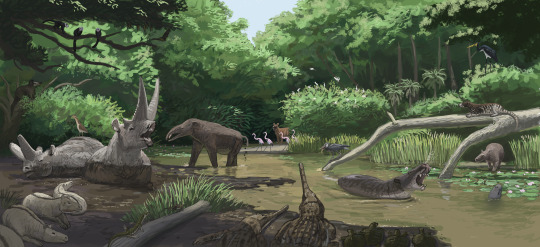
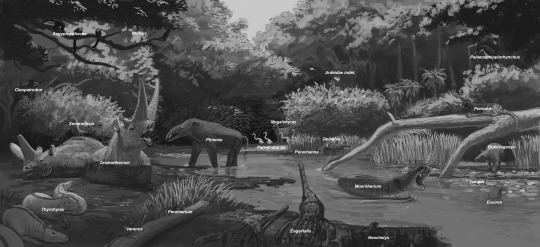
Results from the Jebel Qatrani formation #paleostream!
Arsinoitherium might be the most iconic animal from here but that doesn't make the rest of the fauna less interesting!
#jebel qatrani formation#gebel qatrani formation#fayum#egypt#paleontology#palaeoblr#long post#xenerodiops#palaelodus#janipes#jacana#flamingo#crocodylus megarhinus#eogavialis#eogavialis africanum#thoracosaur#croc#crocodile#gharial#eusuchia#oligocene#prehistory#goliathia#shoebill#paleostream
405 notes
·
View notes
Text
Look at all these Bunnydolls ‼️💙✨💙
(For lil help here,send me the next Bunnydoll child I can draw next and I’ll be sure to make a list of what to draw next 💙)
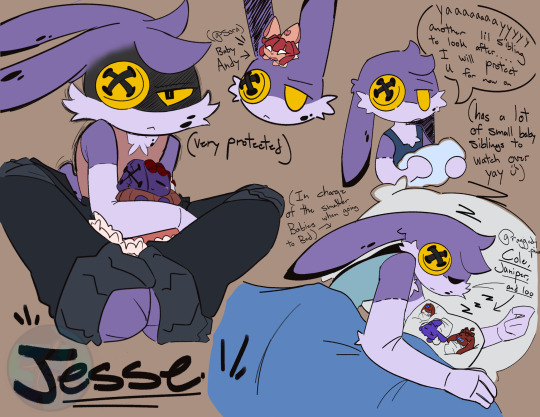
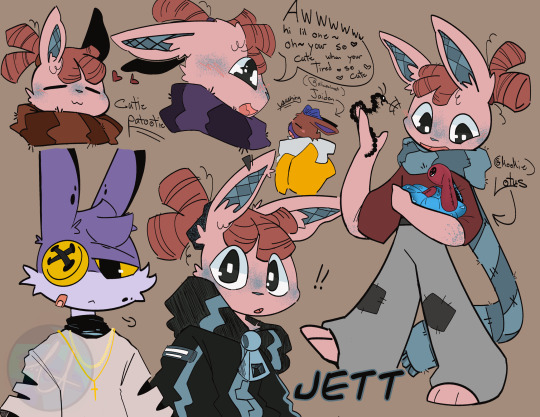
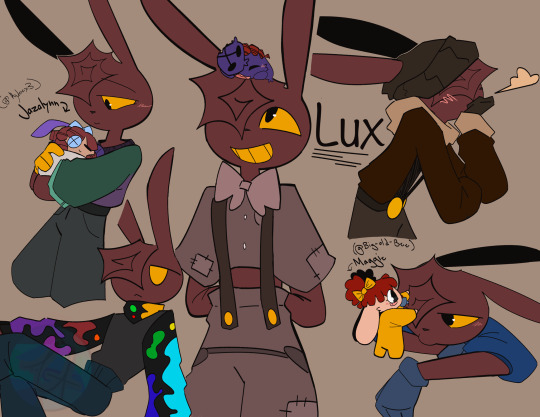
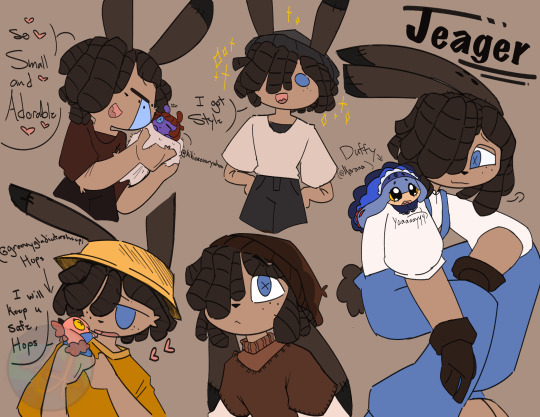
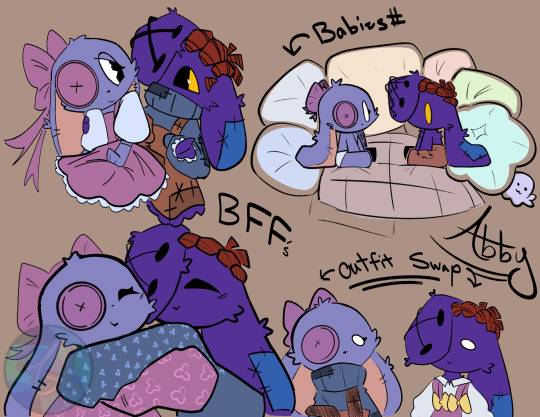
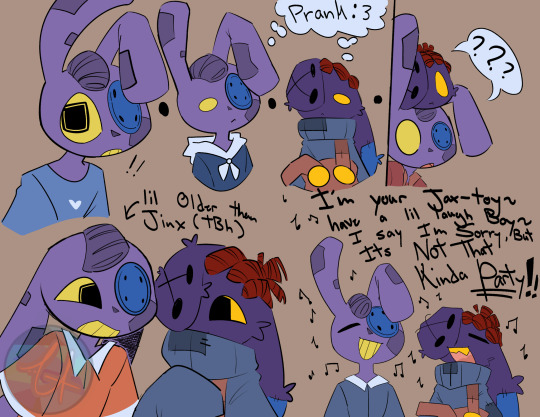
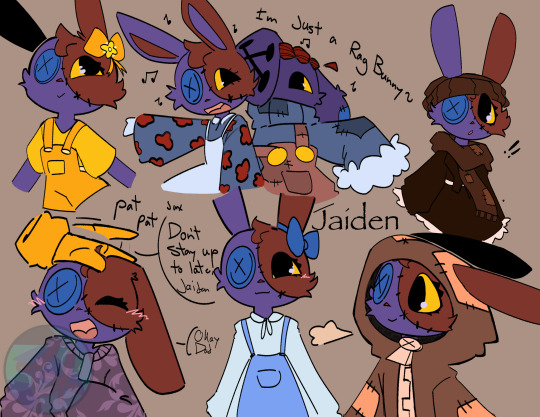
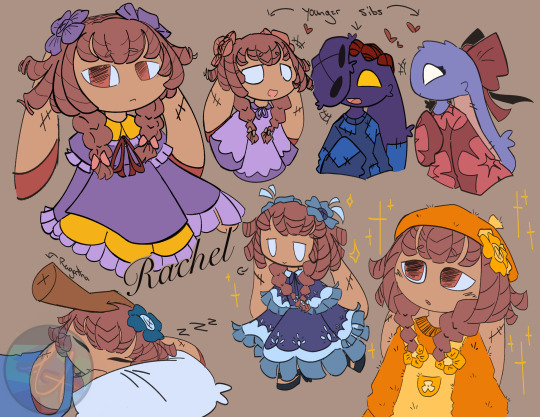
I hope you guys enjoy song Bunnydoll children
These are what I got so far to show yall
(This is only the beginning hehe ✏️)
Older ones:
@ruezzy -Jesse and Jett
@naitmeir - lux
@michiruxbna - jeager
Younger ones:
@fizzyellouw - Abby
@eco-systeme -Jackie
@alicealmost -Jaiden
@kansuda2478 - Rachel
#tadc#the amazing digital circus#the amazing digital circus fanart#ragatha x jax#jax x ragatha#tadc ragatha#tadc jax#bunnydoll#bunnydoll shipchild#older Bunnydoll#Jesse#Jett#lux#jeager#younger Bunnydoll#Abby#the babies#Andy#cole#janiper#and loo#jazalynn#Maggie#hops#Duffy
223 notes
·
View notes
Text


BAKA! BAKA! BAKA!
#what do you mean I never posted these guys JHXDFG#Three doctor OCs... green one (Janiper) belongs to my friend Csy and the red one (Rikki) belongs to my friend Ame#and of course ms blue is Emera#Arknights#Arknights OC#Arknights Doctor#my ocs#oc#original character#friend's OCs#Csy's OCs#Ame's OCs#sunginasong#acsylia#Dr. Ephemeral#Dr. Emera#Emera#my art#doodle#2024
9 notes
·
View notes
Text
Janiper art as my friend calls it sighhh
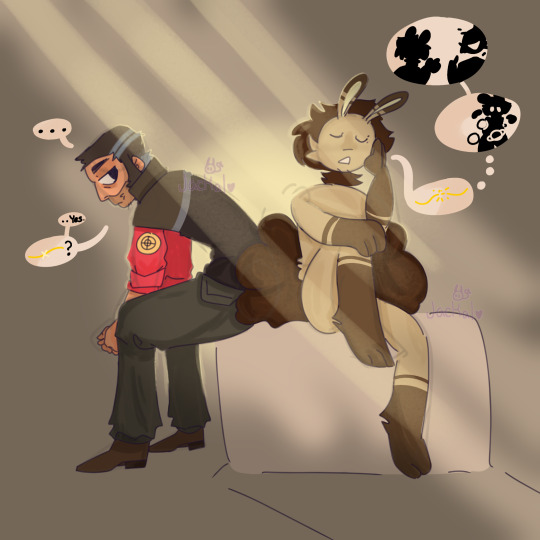
GOD I LOVE DRAWING SNIPER HE IS SOOOO COOL BRO (click for better quality!)
#digital art#art#team fortress 2#team fortress 2 fanart#team fortress two#tf2#tf2 fanart#tf2 sniper#mick mundy#sona
52 notes
·
View notes
Text
Fossil Novembirb 15: Oasis in the Desert
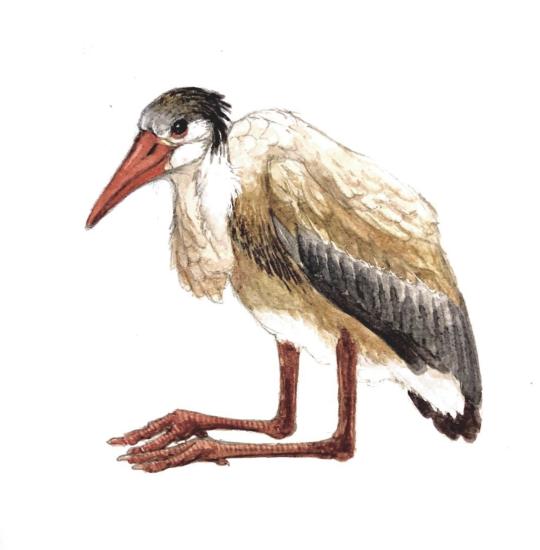
Xenerodiops by @iguanodont
We FINALLY get to an ecosystem that isn't in Europe, North America, Antarctica, or Oceania - it's Jebel Qatrani Time!
(If you are as appalled as I am at the low sampling rates of fossil localities in Asia, South America, and Africa, welcome to the club, and support paleontologists who are from and work in countries from those continents!!!)
The Jebel Qatrani Formation is an ecosystem from Egypt at the end of the Eocene through the early Oligocene. It showcases the tropical forests, swamps, and marshes that existed at this time, emptying into the Tethys Sea. A wet and humid environment, it would have been a weird mixed ecosystem, with both the old and the new coexisting on the riverbanks. And, like in the forests and plains of Oligocene Europe, we see many modern bird groups show up for the first time here - and also very similar to their living relatives! This is a departure from the mammals in the region, which were unique and weird for the time period (though early members of modern groups are found here, too).
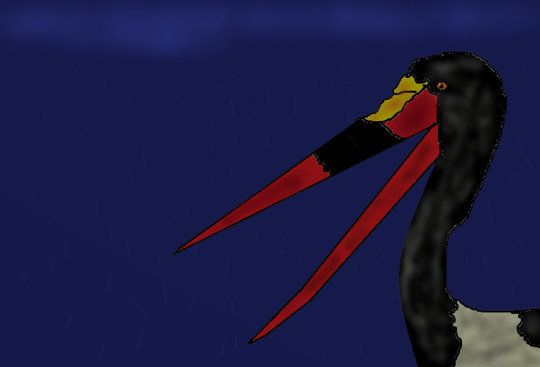
Palaeoephippiorhynchus by Bubblesorg
Being a wetland and humid environment, the main feature of the avifauna here are aquatic birds - many of which have close relatives today. Palaeoephippiorhynchus is the oldest known fossil stork, and was remarkably similar to the living Saddle-Billed Stork - even having the same upcurved bill. While it's uncertain if they're close relatives or not, it is possible that living Saddle-Bills are similar to this ancient form. There was also a mid-sized heron, a bird extremely similar to living Black-Crowned Night Herons, and Xenerodiops - a heron with a pointed and strong bill, curved downward - good for grabbing onto prey. It was a very sturdy, robust bird - even for a heron.
In addition, there was Goliathia - the fossil Shoebill! This bird had legs much like the living shoebill, and was similar enough in the limbs that it might be in the same genus! It probably lived very similarly to living shoebills, feeding on fish in the wetlands around it. What its beak would have looked like is uncertain - the closest living relative to the Shoebill is the Hammerkop, which has a very different skull. What their ancestral skull was, or what Goliathia's was, remains a mystery.

Goliathia by Antonio Rares Mihaila
But if you think I'm done with the water birds, you're very wrong - this is just the beginning! There was also an indeterminant cormorant, which had a very hooked and tapered beak; birds similar to living crowned cranes and others like living flufftails; early jacanas like Janipes which was bigger than all living jacanas but still had the large feet for floating on vegetation, showcasing the vegetation in these wetlands was sturdy enough to hold it up; other early jacanas smaller in size as well like Nupharanassa; and of course -
The Flamingos! Well, yes and no. There was an indeterminate crown-flamingo (ie in the group that all living flamingos are in), a bit bigger than a living lesser flamingo. But there was also Palaelodus - one of the "Grebe-Flamingos" or "Swimming-Flamingos", a long-lasting group of birds that first appear in the early Oligocene and lasted until possibly the Pleistocene! They looked superficially similar to living flamingos and were more closely related to them than to grebes, but they did have some similar characteristics to grebes as well - specifically having less of a kink in the neck, shorter lower legs, and flatter limb bones like those in grebes. They also had webbed feet, which would have allowed for diving or swimming. It also had a straight, conical bill, very unlike the bill of living flamingos.
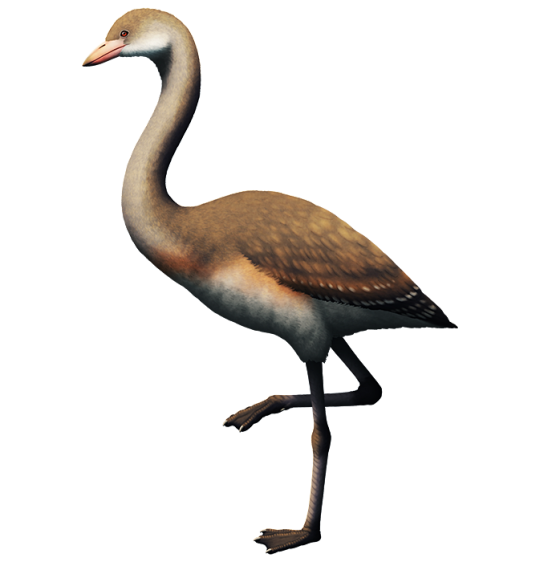
Palaelodus by @alphynix
There were also perching birds, such as an early turaco very similar to the living genus Crinifer; and early eagles, ospreys, and other birds of prey that haven't really been named - mainly because they are very similar to living species, but so distant in time it seems unlikely they'd be in the same genus still... right? One, very similar to the living sea eagle, was found near the shore - indicating a similar ecology to its living relative. Another was almost identical to the living osprey, just smaller in size. And another was similar in size to living ospreys, but more robust than them. This place was filled with raptors!
Of course, I can't ignore the metaphorical elephant in the room. One of the most mysterious birds of the Jebel Qatrani is Eremopezus, a bird that has similarities to so many different groups of birds that its exact position is still a mystery. At this time it is thought to be a Palaeognath, possibly closely related to ostriches or maybe elephant birds - as the volant Lithornithids start to disappear, ratite-like Palaeognaths become more and more common. It was flightless, and probably lived similarly to modern ostriches and other ratites - as a a large herbivore, probably taking advantage of the wetland landscape and the abundance of food.

Eremopezus by @thewoodparable
Jebel Qatrani is such an important formation because it sheds light on the evolution of even more bird groups than those we see in former Laurasia (North America + Eurasia). And it is possible that many lineages we still have in Africa today have been around for thirty million years - and may have been very similar in ecology and appearance during that whole time. Given living birds react to changing climates by shifting with the ecosystems, it's possible that these lines of birds similarly followed the migration of wetlands and other habitats during the climate change to come, persisting to this day across the continent.
Sources:
Kampouridis, P., J. Hartung, F. J. Augustin. 2023. The Eocene-Oligocene Vertebrate Assemblages of the Fayum Depression, Egypt. The Phanerozoic Geology and Natural Resources of Egypt. Advances in Science, Technology, & Innovation. 373-405.
Mayr, 2022. Paleogene Fossil Birds, 2nd Edition. Springer Cham.
Mayr, 2017. Avian Evolution: The Fossil Record of Birds and its Paleobiological Significance (TOPA Topics in Paleobiology). Wiley Blackwell.
Rasmussen, D. T., S. L. Olson, E. L. Simons. 1987. Fossil birds from the Oligocene Jebel Qatrani formation Fayum Province, Egypt. Smithsonian Contributions to Paleobiology 62(62): 1-20.
71 notes
·
View notes
Text
in case anyone was wondering how my nicknames mutate i was thinking abt how if i knew someone named janice i'd probably end up nicknaming them janip or turnip and then that would mutate to nipnip or nipple.
3 notes
·
View notes
Text
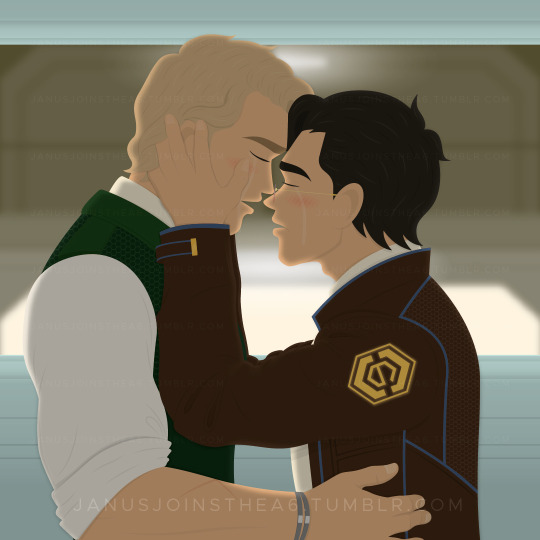
"If I keep you away from the down side of me You can keep me a drip of the light that you see I believe that you're all that you said you would be [...] And I believe, I believe And tell myself to think forward I will show I believe And hold you up and know that you're all I see in the light And never do what I used to" — “Down Side of Me” by CHVRCHES (2015)
In which Janus and June have that heart-to-heart talk in Cursa and make up. 😭 And perhaps have a romantic moment that gets interrupted by the damn K'Merii 🙄.
Angst hasn't always been my strength, but I am here once again trying new things because Sad Yeehaw Hours™ is part of The June Experience™. 🥺👉👈💚
Anyway, please support the Andromeda Six game by playing here (itch.io) or here (Steam)!
#andromeda six#janus peg'asi#june nyux#juniper nyux#janiper#wanderlust games#andromeda 6#a6#andromeda six fan art#andromeda six fanart#a6 fan art#a6 fanart#andromeda six traveler#a6 traveler#andromeda six mc#a6 mc#visual novel#visual novel fanart#andromeda six june#a6 june#juniper nyux x traveler#june nyux x traveler#juniper nyux x mc#june nyux x mc#art by janusjoinsthea6#filed under: janiper art#okay wow i just made angst and wow it is so hard#but i believe it is the effort that counts so yeet~
68 notes
·
View notes
Text
Inspiration from this list: 63. Indigo skies just before dawn
“Penny for your thoughts?”
Janus smiled, turning her gaze from the window to look at Piper. She was still rubbing the sleep from her eyes, only stopping to wrap her arms around her waist, pulling Janus closer to they were almost nose to nose.
“Just enjoying the sky. I couldn’t go back to sleep,” Janus said, pecking a quick kiss to Piper’s lips. “I’m sorry if I woke you up.”
“You didn’t, don’t worry. I’m not going to bite your ear off for it,” Piper teased, running her hands up Janus’ back lightly before settling them around her waist again, eyes turning toward the window. “Is it nice out?”
“I think so,” Janus said, turning her own gaze back to the window. “I think it might be a really nice day.”
Outside, it was still dark, the sun on the verge of rising. There were many clouds still in the sky, everything painted a beautiful indigo, but from just standing there things were clearing up quickly. The two stood quietly for a few moments, enjoying the peace of the early morning, the streets of Lunaris calm for now. Piper was the first to move, sighing quietly before she pressed a warm kiss to Janus’ neck.
“We should make breakfast. Actually have time to eat it for once.”
“I’ll make us some drinks if you want to start it, then I’ll help,” Janus said, a small bit of laughter in her voice.
“Janus Allaway, you rebel. The sun isn’t even up and you want to drink,” Piper said, a wide grin forming on her face. She laughed as Janus rolled her eyes, easily moving out of swatting distance to go to the kitchen.
“Not those kind of drinks. Not yet, at least.”
#When The Night Comes#WTNC#when the night comes game#WTNC game#Piper Meriman#Fan hunter#Janus Allaway#Ship: Janiper#My writing#Piper x Hunter
9 notes
·
View notes
Text

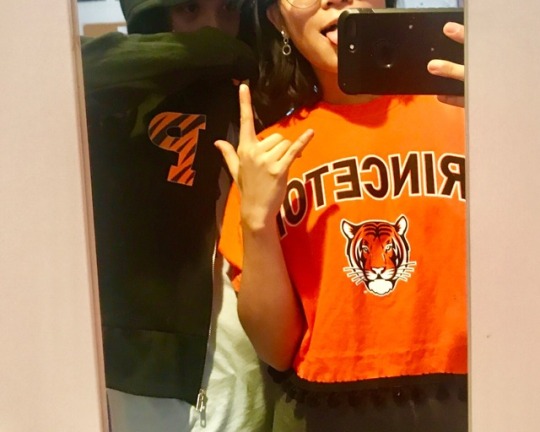

can’t believe i forgot to tell u guys for this long but i’ll be going to princeton university to study public policy and polisci next year!
extremely excited to be a tiger🧡🖤
#janiposts#new studyblr#organization#study motivation#studyspo#studyblr#studying#bujo#my bujo#studygram#study inspiration#princeton#college#college visit#university#janislife#ib#international baccalaureate#ibdp#janipics
12 notes
·
View notes
Text
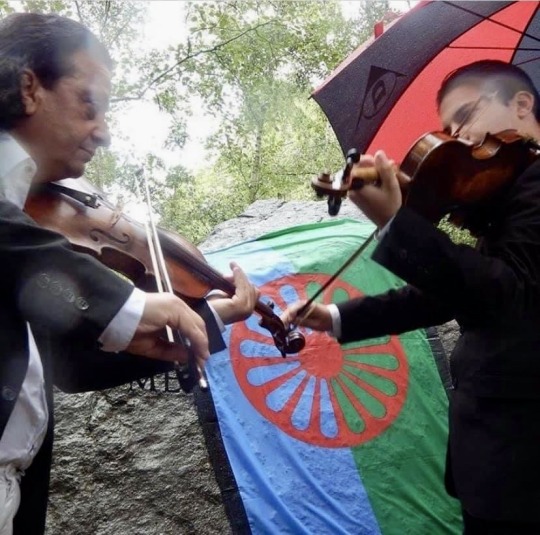
ROMENGO HOLOKAUST
by Emil Krik 28.7.2022
SATHARIPE – PRAHONDIPE – SAMUDARIPE - PORAYIMOS
O alav Holokaust si but diskutimo kana vakarolpe vash Romengo Holokaust. Ji adive shunyem yaver yaver alava pi Romani qhib thay odoleske dikhav dromesko te dudlarav akava alav. Amen may anglal ka muthava e alavesko janipe thay edeya var akale alavesko vastinipe – nakhavipe pi Romani qhib vash te ovol amenge yekh po konkretuno janipe thay vakaripa vash akava alav.
O alav Holokaust avela kotar Grkikani qhib “Olokaustos” Satharipe. Akava alav si kerdo kotar duy alavengo himinipe, kotar “olo” sa thay “kaustos” tharipe dela satharipe ( prahonipa-prahokeripa) thay akava alav vastisalo ko purane Grkya thay Rimlyanya vash satharipe e yagaha yekh kurbani vash o Devel vay vash deyekh mulesko ruhi. Kana hraminyem phrahokeripe odova muthavela so akava kurbani thablola sa, ji ovela phraho. Akaya tradisiya therde vi o purane Izrahilya –Yahudiye - Bibolde ano kurbanideyipe tharindoy sa o brako e yagaha, kova ani Hebreyengi qhib akharyola “Olam kalil”.
Sar so dikhena ano telyaripe amen denyem sa o anava kolen amare Roma adive vastinena kana vakaryola vash Holokaust numay me gandinav so amen vi ko nakhipe shay te hramina o alav Holocaust kova si orginal anav kova vastisalo upral Roma, Yahudiye thay yavera, numay te manglem te vastina Romano alav edeya var may adekvatuno alav si Satharipe.
Kana dikha e Nacistikana Germaniyaki ideya, kola mangle te shusharen e Germaniya thay o rashtre kote thagarinde, e Yevreyenda, Romenda, Slavyenda sar thay e yaverenenda kola sine mamuy olenge vay odola kolen gandinde so nani shushe rateske, mashkar olende vi o Komunistya, Homoseksuvalya, Yehovake Tasvidya - svedoci, godyata nasvale manusha-deline, langavde…), edeya var shay te vakaryol vi Samudaripe. O Yahudiye ani Hebreyengi qhib vash Holokaus akharena Shoah (HaShoah) kolako janipe si katastrofa.
O alav Porayimos, kova si but shundo ko Roma, kana vakarolpe vash Holokaust, denya o romologi o Dr.Yan Hankok, numay, akava alav namutavela odova so si Holokaust. O alav Porayimos-poravimos kova vakaryola ko Vlahune Roma, ano yaver diyalektya vakarlape poravipe, thay o alav poravipe muthavla diso so putaryola, sar misal o Roma phenena: So porave te yakha? Akale vakaripasta halyova so o poravipe si diso so putaryola a na so tharyola.
O alav poravipe vakaryola kana o yakha putaryona pobut odolesta so si normaluno a odova si kana dikha diso so nasiyem sikhle te dikha, shukar vay nashukar, thay baryola e dikhipasko mangipe.
Si Romano alav kova vakaryola parunipa, thay akava alav liparyola vash kana paruna yekhe mule thay te gandisalo agyahar edeya var akate shay te vakaryol Romengo parunipa, odova muthavla vash Romengo mularipa thay parunipa. Akava vakaripa si pashe e alaveya samudaripa, soske sa odola so mudaryona parunyona. Numay, amen jana kotar Romani qhib, so o alav samudaripa nani reyaluno alav odoleske so akava alav na vakaryola vash manusha-jene pi Romani qhib diket vash jivutne, sar misal, yekh guruv mudaryola jik yekh manush mularyola ( mudalo guruv- mulo manush). Si gandipya so akava alav parunipe kova liparyola adive ko Roma, avela kotar alav prahonipe thay ani Indiya ( Hindusya, Sikya, Budistya, Jayinya…) o manusha kana merna ol tharena olen thay olengo praho parunyola-garavyola ani limori. Te sine agyahar, edeya var o alav Holokaust shay te akharolpe Prahonipe, agyahar sar denyem po upre ko tharipe, numay kana vakara Holokaust edeya var gandina so o Roma, o Yevreya vay o yavera kola sine Nacistikana Germaniyake viktime, mulardile thay thabile thay odoleske o alav Satharipe si odova vakaripe kova si may reyaluno vash alav Holokaust.
Romengo Holokaust si may pharo kotar sa odova so kerdilo e Romenge ani olengi migraciya. Ol na kamlile ano niyekh than kote khuvde. Ano thana kote khuvde, disave mulardile jik odola yaver paldisale numay e Nacistikani Germaniya ko qekat e Adolf Hitlereya, mangla sa te kosol e Romen sar naciya, vakarindoy so si melale rateski naciya agyar sar si vi o Yevreya.
O Roma na sine shukar ajukarde vi anglo Hitleresko thagaripe agyahar sar mothavyem ano kotor Romengo Eksodus. Ko bersh 1899 kotar Germaniyaki Policiya sine yekh ulavdo reparti kova lelaype numay kontrolipaya e Romen. Bersh po bersha e Romengo jivdipe ani Germaniya ovlay po phare thay kotar o bersh 1920 ji ko bersh 1930 o nacizmi mamuy o Roma kerya olengo jivdipe po phare. Numay o Roma vi te sine mejbur te theren pa paste spesiyalune identifikipaske kartice, ol popale shukar integrisale ano Germaniyako amalipe thay yekhethane e Germanyensa khuvde ani 1. Sumnaleski mareba. Asavko integripe kerya so but Roma prandisale e Germanyensa thay olengo rat himisalo mashkar Germanya. Sa akava shukar integripa na pumushkarya te na oven paldime thay mularde kana alo o Hitler ano thagaripe.
Akate si shukar te liparyol so o Rashaya ani Germaniya thay yaver thanende, kola therde bari rola ano thagaripe, vakarenay so o Yahudiye, kola mularde e Hz. Isa, si doshale thay armandune kotar o Devel thay ol manglape sa te koslon kotar akava Sumnal. Numay, te na bistaryol so vi o Roma sine na shukar ajukarde odoleske so o Roma, sar gandinyol, kerde o karfina kolensa mulardilo o Hz. Isa thay odoleske vi e Romen mangle te kosen akale Sumnalesta sar jene kola si armandune e Devlesta.
Sa akava so gandinde o Rashaya thay o Antisemitizmo ani Germaniya, o Hitler mangla te kerol reyaliteti. Agyahar kotar o bersh 1933 kana o Hitler alo ano thagaripe, vash Roma thay o Yevreya o pharo jivdipe irasalo ano meripe.
O Hitler gandinlay so, o Germanya kola perna ani Ariyengi rasa, si may shushi rasa thay ol manglape te thagarinen ano Sumnal jik o Yahudiye thay o Roma perena ani may teluni-melali rasa thay odoleske ol manglape te nashalyon akale Sumnalesta thay odoleske mangla te shusharol e Germaniya akale ”melale” nasiyenda.
Vash te kerolpe akava shusharipe may anglal anena yekh kanuni ko bersh 1935 e anaveya ”Nunbergesko Kanuni” kote may anglal lelola e Yahudiyengo napal vi e Romengo rashtranipe (drzavljanstvo) thay akale naciyen lelile te keden ano koncentraciyonalune logorya. Agyahar 1936. bersheste e Sinte Romen lele te phanden ani Dachau Koncentrasionesko logori sar Germaniyake ”asocialune” manusha thay ano olenge gada thovde o hram ”Z” sar zigeuner. Akale logoresta yaver e Romen biqhalde vi ano yaver logorya sar Eleru, Oberlik, Venhauzen ty. Sar o Roma ani Germaniya tretirisale sar melale rateske manusha, jene kola na mangena te keren buti - parazitya, kriminalya, kerdilo plani vash te shusharyol e Germaniya e Romenda vash te na melalkeren vay nasvalkeren e Germanyen. Agyahar 21. Septembri 1939 bershete adikardilo angluno thay 30. Januari 1940. bersheste duyto kedipe kote o Hajdrih pere godideyutnenca anena pratsav te keden mashkar yavera vi sa e Romen ani Germaniya thay te biqhalen-deportinen ani Polska thay vash akalesko reyalizipe putardilo ko Berlin nevo spesiyaluno biro e anaveya Sekciya IV D4 kolako sherutno sine o Eichman.
O Roma may anglal kedisale ano Germaniyake trin bare diza sar so si Hamburg, Köln, Stuttgart ty. O gindo kotar 30,000 milye Roma-Sintya kotar odola bare diza dromisale ani Polska ko logorya Belzec, Krychkov ty.
Sar o Roma jivdinde vi anglo Hitleresko avipe ano thagaripe ani Germaniya, o Roma sine himisale, kotar rat, e Germanyensa odoleske ko nilay 1941. bersheste o Dr. Robert Ritter thay i Sociologa i Eva Justin kotar Instituti ano Berlin, kola therde pashe sa e Romenge anava kedimi ani bari-kali kartoteka, sine anavkerdime vash te keren seleksiya ko Roma. Agyahar ol e Romen ulavde ano disave kategoriye:
•Odola kola sine qaqune- shushe Roma sine ani kategoriya Z
•Odola kola sine kvash Roma kvash gaje sine ani kategoriya ZM
•Odola kola sine kvashesta po but Roma sine ani kategoriya ZM+
•Odola kola sine kvashesta po hari Roma vay sine kvashesta po but gaje sine ani kategoriya Z-
•Odola kola na sine Roma, sine gaje, sine ani kategoriya NZ
Pali akaya kategorizaciya ko 16. Decemri 1942 bersheste o Himmler Heinrich, anela pratsav thay biqhalela lil vash te biqhalyon sa e Germaniyake Roma ano logori Auschwitz- Birkenau thay othe te mularyon.
Sar phendilo ano Auschwitz ka biqhalyon numay o qaqune Roma kotar kategorizipe jik o yavera ka aqhon ani Germaniyake phuva. Numay vi te vakardilo agyahar, ano meripasko logori Auschwitz biqhaldile vi odola Roma kola namanglape sine te biqhalyon.
Ano Auschwitz – Birkenau vay numay Auschwitz II andile o Roma thay o Yevreya e trenensa-vozenca thay kotar avipe yekhatar ulavyonay ano duy grupe: Odola kola ka mulayon yekhata thay odola kay ka hraminyon sar logorashya. Ani angluni grupa sine kotar 75% jene kola yekhata biqhaldile ani gaseki komora. Ani akaya grupa pernay o juvla, o qhave, o phure thay o nasvale manusha jik o yaver 25% sine odola kola dikhyonay po zorale kotar doktoryengi inspekciya. Ano akava may baro meripasko logori, o kapaciteti sine te mularyon vay te thablon-kremirinyon disave milya jene ko dive. Ano akava logori mulardile vay thabile 960.000 Yevreya, 750,000 Polyakya thay 19.000 Roma.
Sar si amari tema Holokaust edeya var, kobar si janglo ano akava Auschwitz- Birkenau, ko 25 Mayi ani gaseski kamra mulardile- thabile 1000 Roma jik ko 2-3 Avgusti panda 3000 Roma.
Kobar si qaqek o gindo akale Romengo kola mulardile ano Auschwitz qaqipaha na janyola numay akava gindo si odova kova hraminyola kotar rodlarde kana hraminen vash akava logori. Vash na-arakhipe e qaqune gindengo si odoleske so e Germaniyake SS-lurde/ askerya tharde buderi lila vash te na mukhen genociteske vurme. Odova so janyolpe sar sine o jivdipe ano akava logori halyova kotar o lil kole mukhla o sheruno e Auschwitzeske logoresko o Rudolf Höss, kova krisisalo ko meripe thay umlavdilo 16.04.1947 ano logori Auschwitz-Birkenau. Akale lilesta halyova so o Auschwitz sine pherdo e Romensa. Nashukar saniteripe, pherde o bolnice e naboremensa, nasvale qhave e qhavrikane nasvalipasta Nome-muyeski gangrena, o neve biyande qhave na jivdinenay maybut e disave divenda; Ov hraminela vi so o Himmler, kana akharya ole ko Berlin, vakarya oleske so sa o Roma thay o Yevreya manglape te likvidirinyon numay disave kola si saste thay zorale vash buti na. Akava Himleresko dekreti ji ko mashkar e 1944. bersheste jande numay ov thay o sasrtlarde- doktorya…
O Roma but cidinde ano akala logorya, sar kotar phari buti agyahar kotar eksperimentipe. Sasave ekperimentya kerdile e Romensa ano akala logorya. Maybut sine odola kotar medicina thay truposko zoralipe. Yekh kotar namanushipe ano akava logori muthavya vi o Dr. Mengele kova sine interesimo e duyengenge-binakyenge. Akava ” doktori” para vrdaya korkoro ningarya e qhaven ano krematoriyumi! O Dr. Mengele sine interesimo vash heterohromiya ko qhave - yakhengi boya yekh kali yekh boldi-qiviti, kolen therde e Germaniyake Romenge qhave. Ov delay dekreti te nikalen e qhavenge yakha thay te thoven – qhiven ano gavunozi vash te ningarol ano Berlin vash te keren pigmentyengo rodlaripe…
Ka lipara panda yekh namanushipe kova kerdilo ano logorya kova muthavela so o bimanushipe ki Nacistikani Germaniya natherya samantre-granica.
O Luy Simon, kova sine Rom thay therya tetovirimo trupo, kana dikhlilo kotar o agentya, dende ole disave suvya kola shuvlarde olesko trupo thay ko Buhenvald hulavde oleski morti truposta thay oleska mortaya dekorinde e komandantesko astali!
ROVA
Rova amare kamlenge,
Mardutnengen, ternenge.
Dayenge, dadenge,
Amare phral, phenyenge.
Rova e baht e Romengi,
So nakamol ola niyekh them.
Rova, rova, rova,
Sakana ka rova!
O Roma mulardile vi ano yaver koncentrasione logorya thay nasine koncentrasiyon logorya so nasine o Roma. O yaver logorya mashkar yaver si akala:
Bergen – Belsen, Buchenwald, Chelmno, Dachau, Lackenbach, Lodz, Maidenek, Mauthausen, Neuengamme, Ravensbrüch, Sachenhausen, Treblinka…
Vash akaya tema thay vash akala logorya po buhle - maybut hraminde o raye Donald Kenrick thay o Grattan Pakson ani olengi pustik “Bibahtale Bersha”.
Vash te iranyova palal ki terminlogiya Holokaust, dikhlem so ano logori Auschwitz – Birkenau mulardile thay thabile o Roma. Agyahar vi ano yaver logorya ani Polska, sar Chelmno kote mulardile thay thabile kotar 5000 Roma kola sine biqhalde kotar logori Lodz, odoleske ano akala logorya ulo Holkokaust e pherdo anaveya jik ano yaver, odola kolen liparyem thay so ka lipara, kote numay mulardile, ulo genocid thay Samudaripa.
O Roma na sine mularde numay ani Germaniya, ol sine mularde ano sa rashtre kote sine tali Nacistikani Germaniya (Evropa-Balkan). Disave akala rashtenda biqhalde e Romen- deportinde ani Germaniya- Polska jik disave korkore ano pere rashtre kerde o Samudaripe.
Si but logorya kola korkore kerde o samudaripe numay amen ka aqhova numay ko yekh logori kova si but pinjardo odoleya kova sine maybaro koncentraciono logori kova kedlay qhave kotar maytikne ji ko 14 bersh. Akava logori si o logor Yasenovac ani Hrvatska. O logori Yasenovac si pinjardo odoleya so ano akava logori ule may phare thay maymelale mularipya. Ano akava logori kova therya panda panj talologorya, kedisale thay mulardile o Srbya, o Roma, o Yahudiye sar rasa numay kedisale thay mulardile vi o sa yaver kola sine mamuy Ustashya, kola therde o thagaripe ani Biumlavdi Hvatskaki Rashtra (NDH), sar Komunistya, Antifashistya ty.
Ano akava logori thay ano thana kote sine Ustashya o mularipe ovlay qhuryaha, tovereya, kashtune sivrenca-maleya, cidakarde ji ko meripe thay mukhle bokhale thay trushale ji ko meripe. Asavke mulen, disaven uqharenay ani har jik disaven qhudenay ani len Sava.
O deportipe e Romengo kova manglaype te ovel vash ki Germaniya, but var na nikyolay kotar Rashtra avri numay pheryonay o vagonya kola sine vash jivutne – janvarya e Romenca thay divensa na putaryonay ji o Roma mernay bokhata. Asavki metoda o Germanya maybut kernay e qhavenge soske ol po sig mernay.
Vash te nashen o Roma akale genocidesta but var astaryonay thay nay nikyonay ani Italiya. Shunyolay so o Ustashya but cidlarena thay qhinena ano kotora sar e baren agyahar vi e tiknen.
Yekh misal kotar jivdo tasvidi-svedok koya dikhla e Ustashyengo bimanushipe si o muthavipe koya muthavela e Angelina Hudoroviq. Olako muthavipe si akava:
”May anglal qhivde mara phenyaka qhaya te putarel yekh har jik olaki day a miri phen koya sine khamni ano eftato masek sine phandli ano yekh kasht. Yekh ustashi e bayoneteya-pushkaki qhuri, putarya olako vogi, nikalya e qhave vogesta thay qhudinya ani har. Napal qhudinde mara phenya thay ko agor vi e qhaya koya disavar zoreya sekskerdili napal uqharde i har tate so ol sine panda jivde.
Ano Yasenovac sine vi Krematoriyum ano kova thabile but Yevreya, Srbya, Roma mashkar kolende sine vi qhave thay odoleske vakarolpe so ko logori Yasenovac ulo vi Holokaust.
Ji adive panda na janyola kobar viktime ule ano Yasenovac numay ano janglaripe kova dendilo ko Mashkarthemutne Askeriyake Kriseske ko Nunbyerg, e viktimengo gindo si kotar 500.000 ji ko 700,000.
Sa Romengo gindo kola mulardile vay thabile ano Yasenovac, ofisiyeluno si 20.000 numay gandinelpe so akava gindo sine po baro thay nakhela ji ko 80.000 Roma.
ANO THAN MERIPASKO
Sarenende yekh po yekh avri nikalde,
Disaven lokipaya, disaven maribaya.
O shere qhinyonay o yakha nikyonay,
Olengo avazi ji po Qeri shunyolay.
Baro rafali sarenend pi hiv araya,
Jivde vash te na aqhon ini e qhurya posavya.
Angali pi angali e phuv olen uqharya,
Pe yakha biphandle, jivdipe bijande.
Palo hari vakti, tali phuv yekh avazi shundilo,
Yekh tikno qhavo e mula data biyandilo.
I ratvali phuv putarde e qhave nikalde
Kotora, kotora o masa pordi day lugyarde.
Nay te mothavav vekye mo vilo izdrolma,
Muken´ma hari te rovav, mo vogi te quqarav.
Te manglen ini (vi) tumen roven manca,
Amenda yaver khonik naka rovol olen.
Akava Holokaust thay Samudaripa kova ulo e Romensa thay eYevreyensa ulo ano periodi kana sine duyti Sumnaleski mareba ( 1939-1945) thay o gindo e Romengo kola mulardile ano koncentrasione logorya ofisiyaluno denyola kotar 500.000 numay sar o Roma mulardile vi bi registrime thay kana janyol so o lila ano Koncentrasionalune logorya thabile, akava gindo si but po baro. Si gandipya kola nakhena ji ko 3.500.000 Roma kola mulardile ano Samudaripe thay Holokaust.
2 notes
·
View notes
Photo

@ilusionsanddelusions @wilkinsound-blog @skibbles665-blog @choppedeagleluminary-blog @marijuana-bunny @janiper @sad-girl-with-a-broken-heart @sxcondhand-smoke @thecoolgifs-blog @lyyd @anaalmeidaaaa
Ray-Ban Sunglasses
21 notes
·
View notes
Text




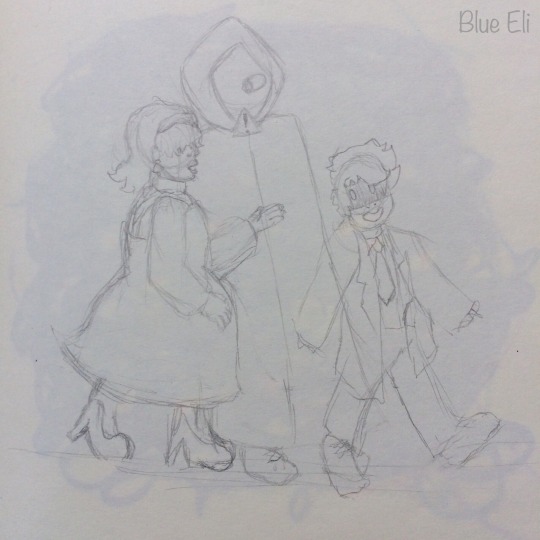



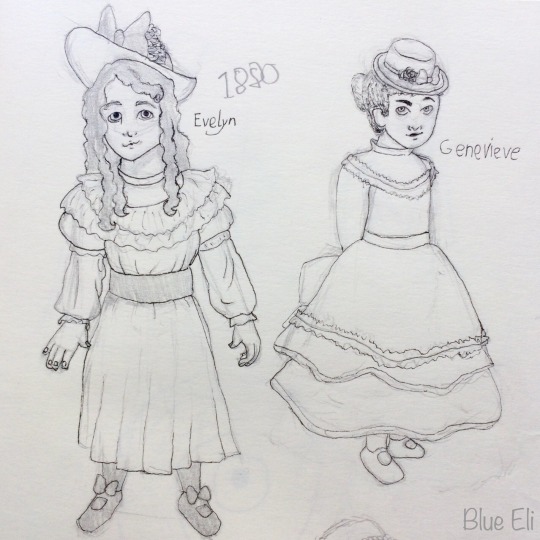
Have some oc doodles I did of characters from tpcai! Please ignore the fact I’m only posting them after tpcai ended I’m just a mess. Both mine and some friends’. I sorta wanna get in to the habit of posting again while also getting more comfortable with posting more casual stuff, so I figured I might post some pictures from my sketchbook.
1. Debbie, Esse, and C4T! Some of The Narrator’s earliest AI. Esse was its first attempt at making human like AI, but Debbie (The second attempt) was more successful. Unfortunately Debbies files got extremely corrupted before tpcai so in canon zey are gone. Aus where 🌈 lives are fun tho. Also C4T is just a simple cat/desktop companion AI who we love but definitely isn’t that sophisticated.
2. Esse, C4T, and baby Gordos! Esse and C4T are still alive and well in tpcai canon and helped raise Gordos. Gordos belongs to @Epicgal13
3. Another one with Gordos! This one set in an au where Debbie lives and gets to meet him.
4. Janiper! Them<3 Jan belongs to @reiney-weather , and Booper belongs to Cobb!
5. The virus siblings! Alarm, Alert, and Popup. Alarm belongs to @cryptid-lemonfkennedu , alert belongs to @cyber-kingdom , and Popup belongs to @20sourlemons .
6. Millie! I love her,,, Millie belongs to @cryptid-lemonfkennedu
7. Evelyn!!!
8. Genevieve,,, Evelyn’s bff
9. Evelyn and Genevieve in the 1880s! The game they’re from takes place in quite a few different time periods.
#I wrote the description for this months ago I just didn’t have the energy to tag it#being disabled is fun/s#anyway @ other tpcai people ily#tpcai#Talorly’s preschool classroom ai#talorly’s preschool classroom but the AI are self aware#wow I love inconsist capitalisation apparently#the janitor#tpcai the janitor#tpcai jan#tpcai janitor#tpcai Booper#officer Booper#I don’t remember all of boopers tags!#or if the others have tags...#might just tag my ocs now#Debbie Meraki#Debbie Meraki (oc)#Esse Cor (oc)#Esse Cor#C4T (oc)#Evelyn Chance Baines#Evelyn Chance Baines (oc)#did I ever give Gen a last name???#Genevieve (oc)#Janiper#drawing#art#fanart#blue boi draws
8 notes
·
View notes
Photo

#YCP #YSRCP #YSJagan #YSJaganCase #YSJaganMurderAttempt Not Single But Dual Murder Attempts On Jagan It is known that Opposition Leader Jagan was injured in a knife attack at Vizag airport. Today in a press meet, Police Commissioner Mahesh Chandra Laddha stated that Srinivas attempted twice to murder YSRCP Leader.
#Janipalli Srinivasa Rao#Police Commissioner Mahesh Chandra Laddha#YRSCP#ys jagan#YS Jagan Murder Attempt
0 notes
Text
Nts: Janiper, River, Snake, Crown
#well kt started ieht a theme#Rjalker trains its gardening skill#fpr the enetuam. avje#eventual hahke#BABIES
2 notes
·
View notes
